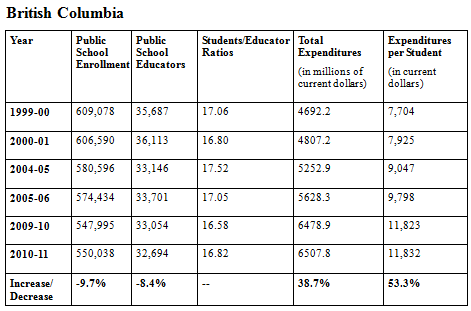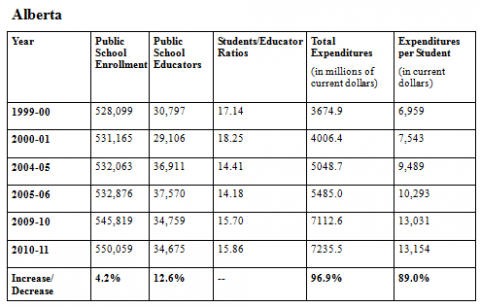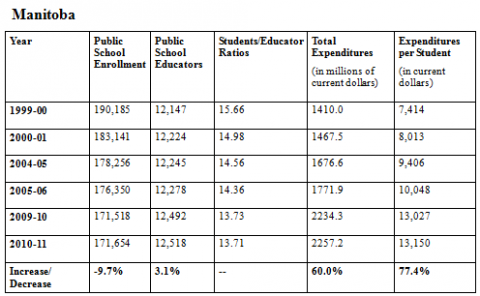Taxpayers have good reasons to be concerned about the skyrocketing costs of education.
Recently, William Baumol, professor emeritus of economics at Princeton University, used the term “cost disease“ to describe the exponential increase in the cost of social services—a rate much steeper than the Consumer Price Index (CPI).
In The Cost Disease: Why Computers get Cheaper and Health Care Doesn’t, Baumol says that the cost of the social services is “condemned” to increase faster than inflation because the number of people providing and using the services cannot be easily reduced.
Western Canada is certainly not immune from this reality. The table shows that from 1999 to 2010, public school enrollment decreased by 10 per cent or more in every Western province except Alberta. Paradoxically, the number of educators increased in every province except BC. In Alberta, the number of educators increased by 12.6 per cent; in Saskatchewan, by 5.8 per cent; and in Manitoba, by 3.1 per cent.
More importantly, the cost of educating the average student in public schools increased in every province in comparison with the CPI, which only went up by 25.5 per cent. The increase in BC was the lowest at 53.3 per cent; in Manitoba, 77.4 per cent; in Alberta, 89 per cent; and a whopping 95.3 per cent in Saskatchewan.
Interestingly, the cost of educating the average student in 2010 was lowest in BC at $11,832, followed by Saskatchewan at $12,470, Manitoba at $13,150, and Alberta at $13,154. In other words, the cost of educating a public school student in British Columbia was 11 per cent lower than in Manitoba and Alberta and 5 per cent lower than in Saskatchewan.
In all four provinces, however, more resources continue to flow into half-empty schools, with fewer students in classrooms, expanded bureaucracies, and higher salaries for administrators and teachers. If the cost of educating students had been held to the increase in CPI, substantial savings could be found, even in BC.
Provincial ministers of education and school administrators often claim that students benefit from lower student-teacher ratios, better facilities, more divisional administrators, and higher-paid teachers. But, there is little evidence to support this claim. In fact, students in BC, where the costs are lowest, have often out-performed students in other provinces.
Rethinking the way education is funded and administered is long overdue. There is a pressing need to lower expenditures and improve students’ educational achievement so that Canadian students can successfully compete with each other and with students in other countries.
The most effective way of doing this is to tie funding directly to demand by using vouchers that increase at the rate of the CPI. These vouchers would allow parents to send their children to any public or private school. Higher enrollments would mean larger budgets, and lower enrollments would mean smaller budgets.
The policy would also eliminate the unfair double burden placed on the increasing number of parents who are sending their children to private schools, such as Sylvan Learning and Kumon Centres. At present, these parents effectively pay twice—first, when they pay private tutors and then when they pay taxes that support public schools—schools that apparently do not meet their children’s educational needs.
Consumer-controlled expenditures would also eliminate a large swath of public school bureaucracy that absorbs considerable resources. Schools would turn away from maximizing spending on peripherals and focus on objective, measurable, outputs that are essential for creating informed, enlightened, and employable citizens.
As a result, students would be tested on the core subjects, and the results would be published so that excellent schools attracted more students and low-performing schools withered and closed. Of course, schools would be free to experiment with new teaching and administration strategies, but they would need to deal with the consequences, both positive and negative.
These changes would save considerable money for provincial governments, making schools much more responsive to the needs of students and parents and much more palatable to taxpayers. Obviously, the cost disease cannot continue forever.
Public Education Expenditures in BC, Alberta, Saskatchewan, and Manitoba: 1999 – 2010




Source: Patric Blouin, Summary Public School Indicators for the Provinces and Territories,1999/2000 to 2005/2006. (Report No. 81-595-M, No.067), (Ottawa, ON: Statistics Canada), 2008; and Statistics Canada, Summary Elementary and Secondary Schools Indicators for Canada, the Provinces and the Territories, 2006/2007 to 2010/2011, (Report No.81-585-M, No.099), (Ottawa, ON: Statistics Canada), n.d.


